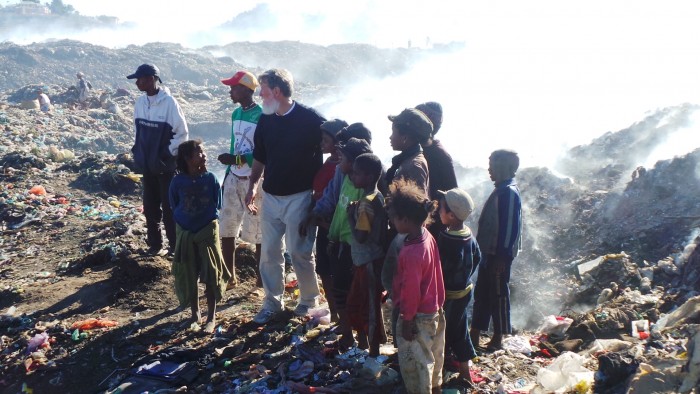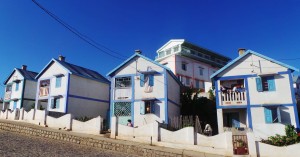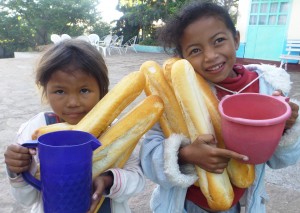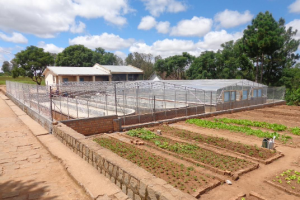MADAGASCAR FOUNDATION presents AKAMASOA
A humanitarian association in Madagascar
founded by Father Pedro Opeka action, hope and solidarity
The Humanitarian Association AKAMASOA has been created in 1989 in order to help poor people of Antananarivo who lived in the garbage dump of Andralanitra and in the streets of the capital. The association aims to move people out of these inhuman places to live a life with dignity. Since the beginning we are convinced that dignity is strongly linked to 3 things: a roof, a work and education. It was unthinkable that these persons still living in an indecent place without access to healthcare.
We started our work with the poor people themselves; we were not able to give the material that they needed; we wanted to move them out of this hell because we were convinced that no human deserves to live in such conditions. We had the belief and faith in a possible better future for this abandoned population. We were also convinced that a sustainable help could not be brought only from outside of the country, and the most important was to change the old habits: we wanted to help but not to assist. It is for these reasons we have always worked with poor people helping them to build structures – schools, work places, dispensaries – which with they could rebuilt their lives and prepared the future of their children.
deserves to live in such conditions. We had the belief and faith in a possible better future for this abandoned population. We were also convinced that a sustainable help could not be brought only from outside of the country, and the most important was to change the old habits: we wanted to help but not to assist. It is for these reasons we have always worked with poor people helping them to build structures – schools, work places, dispensaries – which with they could rebuilt their lives and prepared the future of their children.
We chose to work with these persons who lived in misery. We needed to find a job and leave the garbage dump. We thought that work and countryside could cure and free them from hopelessness, begging, delinquency and crime circle: with some families who wanted to move out, we went to the countryside, 60 km north of Antananarivo, to work the land and build solidarity communities. We needed to go far away from the capital, deceptive promises of the city and of the garbage hell. Find life again.
Together we have built houses in which they are living. First hood made houses and then brick houses and also schools.Quickly, we organized the first village.
 Today, after 27 years of fight, our association AKAMASOA has helped 500 000 Malagasies. 4,000 houses have been built and 25000 persons are living in. Each village has schools, dispensary, and work places: quarry, brick laying, carpentry, agriculture, art and craft. 14,000 children are enrolled in school. And in 2004, our association has been recognized Public Utility by the State, what highlights the need of our presence and action within the social work of the Island.
Today, after 27 years of fight, our association AKAMASOA has helped 500 000 Malagasies. 4,000 houses have been built and 25000 persons are living in. Each village has schools, dispensary, and work places: quarry, brick laying, carpentry, agriculture, art and craft. 14,000 children are enrolled in school. And in 2004, our association has been recognized Public Utility by the State, what highlights the need of our presence and action within the social work of the Island.
We are proud of our achievements but we also know that is not enough. It is a day-to-day fight: concerning problems of each village or poor people who still asking for the AKAMASOA assistance. In 2016, our reception center counted 43,487 persons who needed a punctual emergency aid: meals, clothes, blankets and soap.
 Indeed for a quarter of century we have not seen an improvement of life conditions of the Malagasy population. On the contrary today 9 Malagasies out 10 are living with less than $1, 5 per day: below the poverty line defined by the World Bank. Our fight is more than necessary: we continue, led by past achievements, outraged by the increasing poverty, convinced that we can make it decrease only if we set sustainable and solid structures up:
Indeed for a quarter of century we have not seen an improvement of life conditions of the Malagasy population. On the contrary today 9 Malagasies out 10 are living with less than $1, 5 per day: below the poverty line defined by the World Bank. Our fight is more than necessary: we continue, led by past achievements, outraged by the increasing poverty, convinced that we can make it decrease only if we set sustainable and solid structures up:
- Reception Centers receiving street people and giving a punctual emergency aid (meals, clothes, cares)
- Houses for poor families
- Schools for children from nursery to university and also professional training center
- Dispensaries for health cares
In the following chapters you will find a presentation of the different structures: their goals and way of work. Then, you can consult “Annual Activities Report” to find figures about structures’ activities (houses built in one year, welcomed persons, cured persons…)den board looking for food among rubbish in dumpster: misery met misery.

Centers and villages
The Association is present in many places in the Island; the most significant Center is located in the suburb of Antananarivo but there are structures in province.
Centers close to the Antananarivo capital:
1. Antolojanahary Center (created in 1989) – RN 4, PK 60 – road of Ankazobe
2. Manantenasoa Center (created in 1990) – RN 2, PK 8 – road of Toamasina
3. Andralanitra Center ( created in 1991) – RN 2, PK 8 – road of Toamasina
4. Mahatsara Center (created in 1993) – RN 2, PK 12 – road of Toamasina
5. Ambatomitokona – TalataVolonondry Center (created in 1994) – RN 3, PK 37 – road of Anjozorobe
Centers located in province:
1. AlakamisyAmbohimaha&Safata 400 km South of the capital, province of Fianarantsoa
2. Vangaindrano, Ampitafa 900 km South/East of the country
3. Bethany in Morondava 640 km West Antananarivo (the Capital)

Reception
The Reception Center of AKAMASOA, the most significant center, is located in the Mangarivotra district on Manantenasoa hill (Antananarivo suburb). It is in this Center that people come for all aids. There are dormitories, collective residences, toilets, dining halls and also reception desk. A new building is almost completed in order to have more space in dormitories.
In 2016, this Center welcomed 43,487 persons, on average 120 families per day who needed an emergency aid because they were starving in the street. The Association can’t build brick houses for all but it can give a vital aid.
Main activities of the Center are:
1. The welcome of these families who weekly need an aid represents the principal activity of the Center. AKAMASOA gives to all person coming: a meal, clothes, a blanket or soap. This punctual emergency aid helps people before coming back to their house.
2. AKAMASOA provides a housing in Center’s dormitories. The period of accommodation can varied depending on the situation of each person. But the space is limited that is what has motivated the construction of a new building mentioned above. However, some of these person are permanently living in the Center: people with physical or mental disabilities receiving a medical treatment.
3. But the Reception Center encourages people to live in the countryside to work the land. Indeed many families who lived in the street of the capital or in the garbage dump had left their countryside with the hope of working in the capital. An urban migration which led them to a bigger misery. For persons who want to come back to the countryside AKAMASOA pays the travel and gives means to have tools to work

Education
The educational system is one of the pillar of the Association. All families recently settled in AKAMASOA have to enroll their children at school. In 2015-2016 they were 12,850 in various schools of the Association. 14.000 in 2018.
AKAMASOA’s schools:
1.Nursery
2.Kindergarten
3.Elementary schools
4.High schools
5.University (called “Ecole Supérieure de Pédagogie”)
This constant follow up is the only way to shape stable and independent personalities able to work in adult life and aware citizens active in the nation’s life.
This education is also transmitting essential values for the community life: work, discipline, respect, solidarity.
More than the general education there is also a professional training through carpentry and mechanical workshop. This training offers a significant alternative for children who are failing at school or for children who decide themselves to move toward hand skills jobs. The learning of masonry for the construction of Association’s houses also represents a possibility as work in garment factory.

Health
Each AKAMASOA Center has at least one dispensary.
To give access to health cares to poor people as part of the initial objectives of the Association. And today the AKAMASOA’s biggest health center, located in Manantenasoa counts 1 dispensary, 1 maternity, 1 small hospital, 1 serology and tuberculosis laboratory, 1 ultrasonically room and 1 dentistry.
But these structures still insufficient. However buildings built by AKAMASOA in isolated area of the countryside have already allowed hundreds of people to have access to a medical care.
In these dispensaries all health expenses are in charge of the Association. Furthermore, the Association finances surgical operations and ensures health prevention: hygiene rules for the cluster decrease.

Work place
Since the beginning, the work has been the indispensable requirement to put behind the hell of the street and it has not changed. There was a hill next to the garbage dump where families rotted. This hill also was a dump of misery because since 1985 capital authorities piled there all persons living in the street. Men, women and children were living under cardboard box and wooden board looking for food among rubbish in dumpster: misery met misery.
What we could do when the only things we had were empathy, love and our services? The hill gave work to them; led by Father Pedro, families started to break hill’s stones in order to make rubble stones and gravels which were resold. A work in carry is very hard but decent.
Today this carry allows 720 persons to work. They don’t work for the Association but to build their village. Indeed, rubble stones, cobblestones and gravels are used to build roads and houses of AKAMASOA. Poor people are building their own town.
In the Association other workshops exist but with the same philosophy: metal-welding-electricity workshop makes, among others, concrete posts which give electricity in villages. 30 persons are working in.
The carpentry workshop with 26 cabinet makers trains young people and makes beds, furniture and table-benches for AKAMAZSOA’s schools.
820 bricklayers and carpenters, inhabitants of AKAMASOA, are building houses for new families.
104 persons are maintaining gardens and tree nurseries.
Finally in 2018, 3046 men and women worked to build AKAMASOA.

Reforestation and tree nursery
Each year thousands of trees are planted always around our villages by schoolchild during the rainy season and are maintained during dry season. AKAMASOA also has to make the population aware about the essential role of nature and its maintenance for the future of our children.
We always work with the Association “Graine de Vie” which has created a great nursery near to our Mahatsara village on a land owned by Akamasoa. 16 persons of Akamasoa are working with the reforestation experts of seeds. 20 000 trees,all kind of trees, has been planted over 2018 like it was planned (20 000 trees each year). In this project, Akamasoa and “Graine de Vie” ( an association) offer young plants to association from various regions like Fianarantsoa, Tamatave, Majunga and Tananarive who ask for reforestation.

In 2014 we launched a new project in Mahatsara around the spirulina. The spirulina is an algae with very high nutritive values (iron, vitamin, and protein) used to take measures against malnutrition. We want to cultivate it in order to help starving children but also to sale it as a new resource of Akamasoa. The construction of 4 basins for this crop is now finished, and 4 women left at the beginning of the year 2015 to attend a training about the spirulina crop at the Morondava bishopric. These women will manage the crop and transmit their knowledge.

Sustainability factors
Internal factors
Discipline and citizenship
The discipline in Akamasoa is called Dina: an agreement created by inhabitants themselves (no drugs, no alcohol, no games, no prostitution), but is often difficult to apply. The life still hard for many of them.
Each Saturday morning we meet all together permanent security services which are representing 50 persons to establish the situation of each village as far as thefts, runaway children, fight, rape, domestic violence and other public nuisance are concerned.
Furthermore, Akamasoa’s teams are always here for the population and give a lot of time for moral and psychological support of each person. A lot of time is dedicated to support and listen each trouble.
Spiritual animation has also played a significant role in the awakening of them courage and in the awareness of them responsibilities within family and society.
The Eucharist on Sunday has taken a significant dimension thanks to the massive participation of children, young and adult, almost 7000 persons meet each Sunday in the open stadium of Manantenasoa. But this meeting becomes international because a lot of brothers and sisters tourists come to discover this wonderful and unforgettable moment and to gather.
During the Eucharist, adults participate in the offering and bring the Word of God to the altar. Each week thousands of children prepare new dances making each celebration a beautiful and touching moment.
Association management
517 persons dedicated to the association and who want to do well, are Akamasoa employees. There is a team in charge of the management of the Association with Father Pedro and most of them are teachers, doctors, engineers, technicians participating in the management of many activities. Each day they achieve a huge work: a real fight. Each year we try to take up the challenge making us more performing: to be more performing represents a hard goal to achieve but we are working on.
In 2011 we created a specific Fokontany for the Association which represents a set of different district. Results are positive. The management is serious, there are less thefts, less fights, less children runaways: a real cooperation between Akamasoa security people and the head of the Fokontany.
External factors
At a national level, the status of “Public Utility Recognition” delivered in 2004 exempt the Association of import taxes of food assistance and humanitarian donations coming from the outside. Moreover, the State takes charge of a part (39 out 455) of teacher salary and doctors.
Since April 2010 Akamasoa with its own resources has to provide rice and vegetables to children in elementary school. Thanks to God we are helped by our Slovenian friends (Mission Center of Ljubljana) and Australian (Sydney French Roman Catholic Charities) who are concerned by this major trouble. Thanks to them and the Association, children are less likely to run away or to go to city to find others means of food. At first, the Slovenian help was for 3 years (until 2013) but fortunately it has been re conducted for 3 years so until 2016.
Nevertheless we still worried about future because we don’t have view or guarantee about international assistance continuity.
To meet the permanent needs of elderly without resources, abandoned women and children, emergency measures for the poorest from Antananarivo and around Akamasoa villages, we have to find new food resources. It becomes very expensive for Akamasoa to buy each year hundreds tons of rice and beans to redistribute to each of them. Without assistance all poor people will go back to a dramatic situation where violence and theft could significantly increase.
Akamasoa has a lot to do to reach the goal of total self-financing in order also to well pay each employee. Here, family life still precarious this is why our association need external funding and donation in kind: food, medicine, work tools, clothes…that are given to us so generously by benefactors, anonymous persons, NGO, associations and some National bodies.





